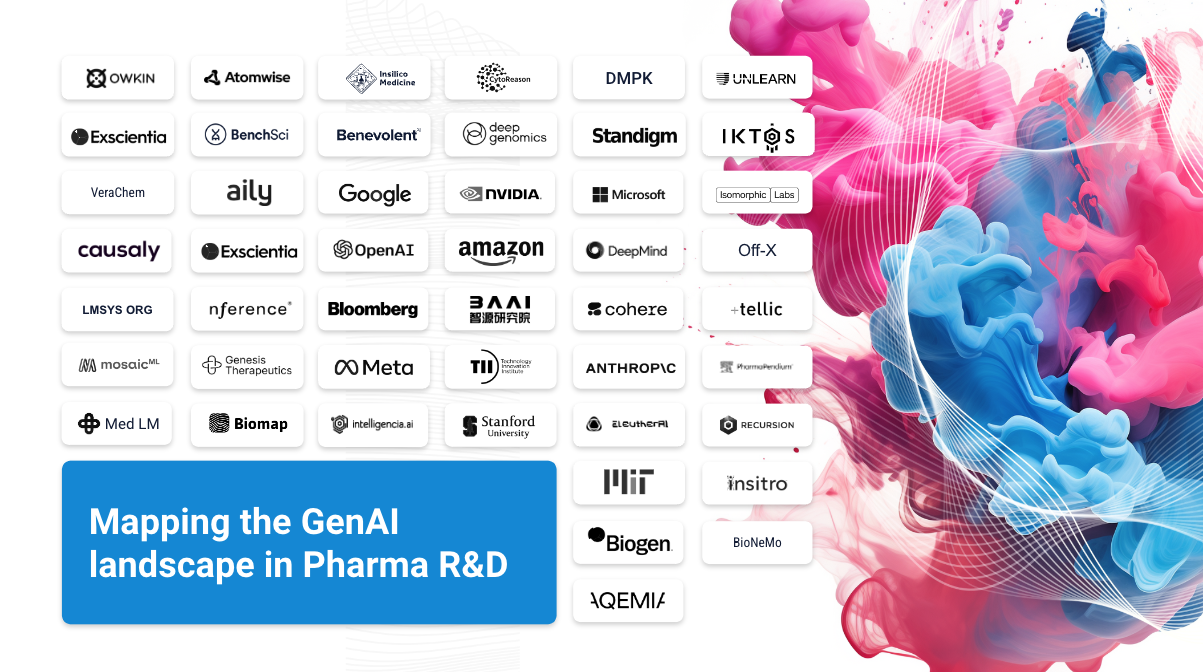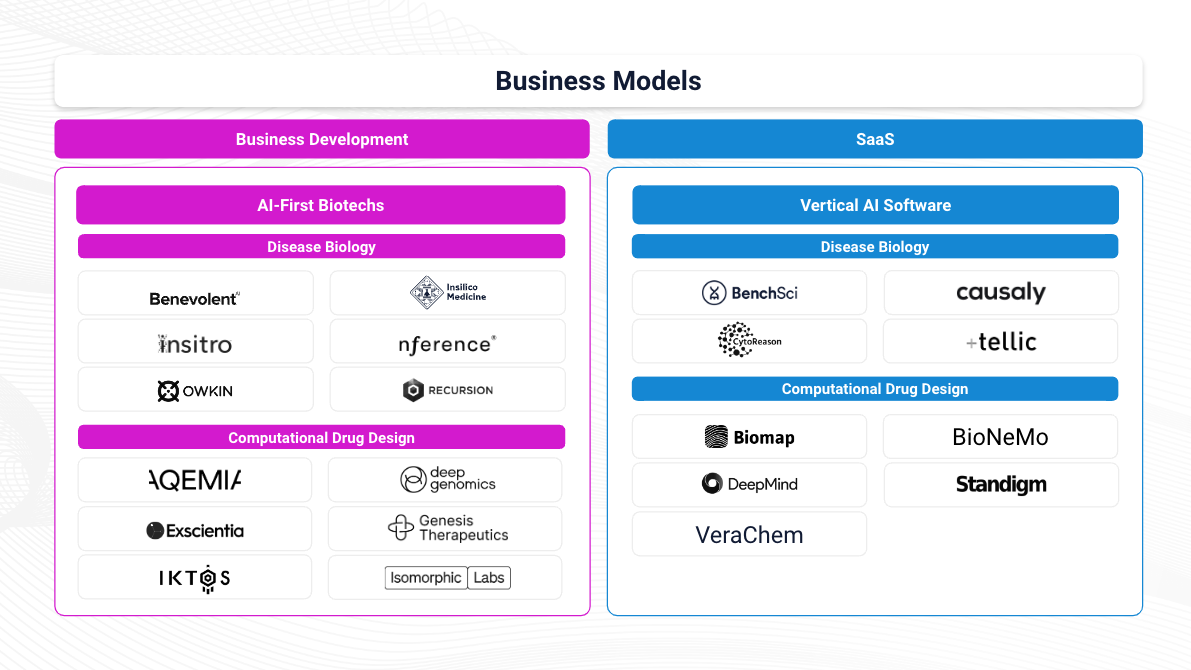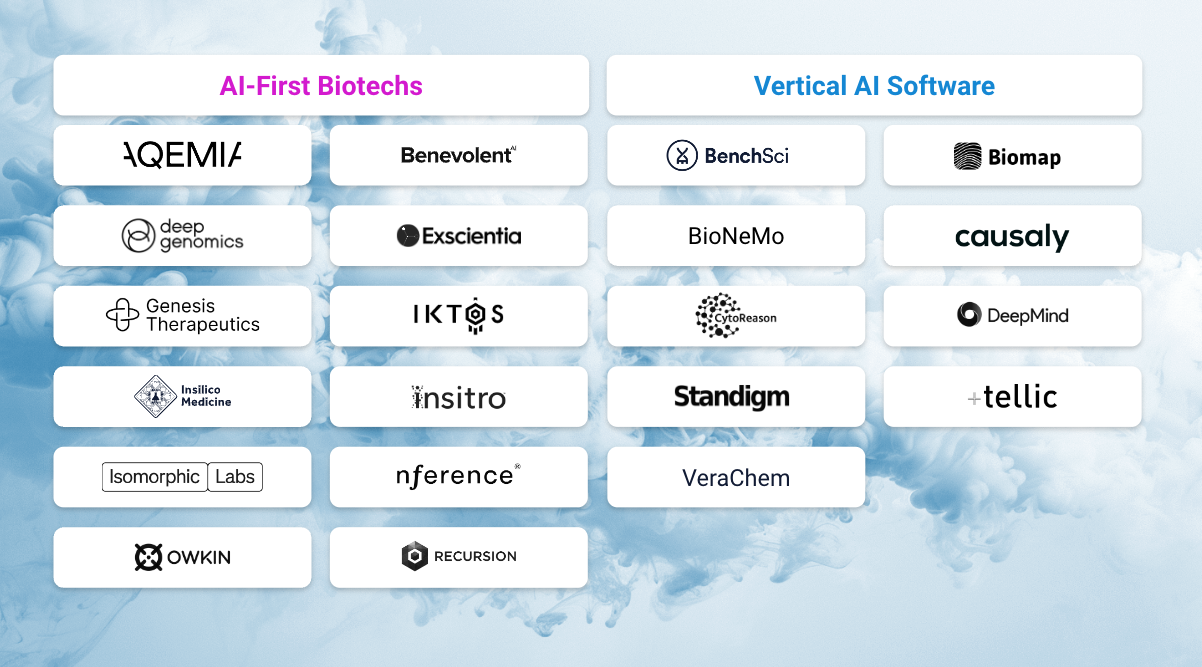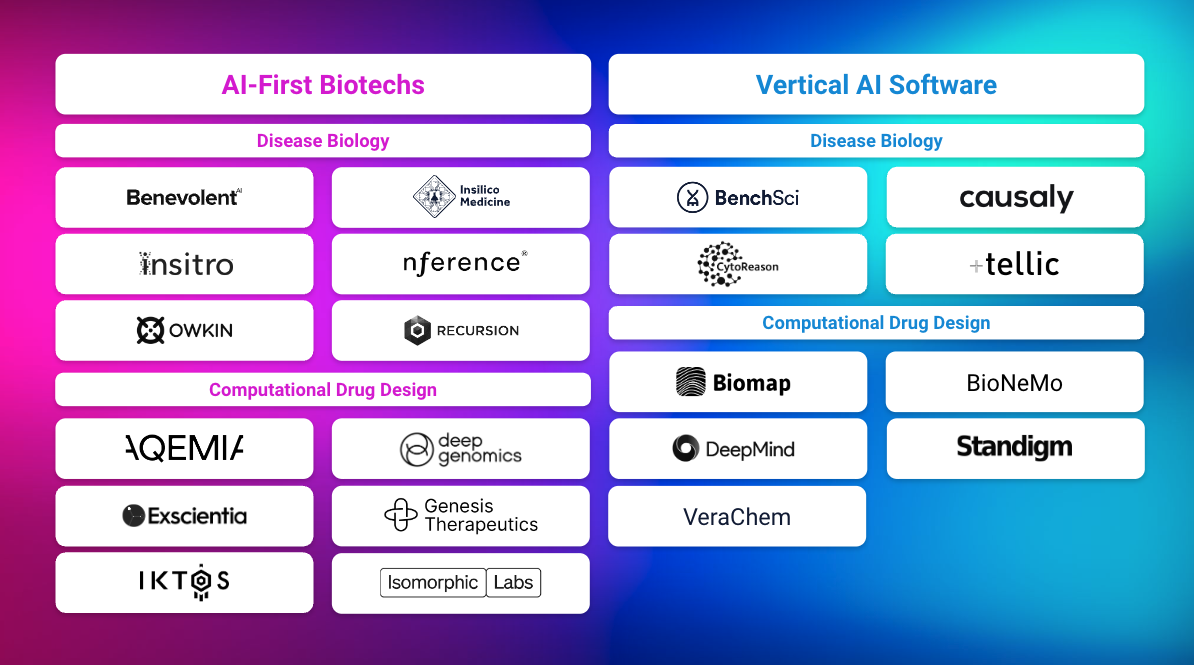While we have made tremendous progress in drug discovery over the last couple of decades, the process of discovering new drugs is time-consuming, intricate, and costly. Today, the pharmaceutical (pharma) industry is in the midst of a transformative era driven by the advent of Generative AI (GenAI). Although AI adoption in pharma R&D isn’t novel, its demand has surged dramatically over the past year with the introduction of ChatGPT. This surge has demonstrated to budget holders and decision-makers alike the significant impact AI can have when effectively applied, offering immense potential to accelerate drug discovery and development across various stages, from unraveling the complexity of disease biology to refining drug design and expediting clinical trials.
This blog post will explore the intricate preclinical R&D ecosystem driving this transformation and the technological advancements and applications shaping this nascent industry.
Navigating the Landscape
The R&D AI ecosystem has exponentially grown over the past 18 months. This influx of innovation is not only exciting but also marks a turning point for the industry. We see AI as akin to electricity and believe it will penetrate every aspect of pharma operations and reshape the R&D process. AI technology is poised to address the very real problems pharmaceuticals face, working to advance portfolio assets and bring life-saving medicines to patients. As the landscape evolves, one of the key challenges for pharma will be to figure out what AI they want to plug into—what their GenAI strategy is and how they build their partner ecosystem, enabling cutting-edge AI technologies. This post presents a framework for exploring partners and strategy, offering insight into the GenAI landscape in preclinical pharma R&D. Partnering effectively can significantly enhance research efficiency, accelerate drug discovery, and improve patient outcomes.

To simplify the complex landscape of AI in preclinical pharma R&D and guide strategic decision-making, our team at BenchSci has developed a three-pillar lens focused on value creation, business models, and scalability. These pillars are fundamental for evaluating AI solutions to ensure they can adapt to your organization's evolving needs. Below, I'll share how we think about each of these.
- Value Creation: GenAI providers offer solutions in three key areas to address drug discovery challenges—unraveling disease biology, computational drug design, and increasing the efficiency of clinical trials (which we won’t delve into, as this blog centers on preclinical R&D). Strong value creation translates to enhanced efficiency, reduced time and costs, accelerated drug discovery, and improved patient outcomes. Additionally, it empowers research teams with advanced tools and insights for efficient data analysis, informed decision-making, and innovation.
- Business Model: A business model outlines how an AI provider plans to engage with pharma companies. There are two primary models: the business development model, offered by AI-first biotech companies, and the Software as a Service (SaaS) model, typical of vertical AI Software companies. The former involves partnerships or co-developments, often leading to novel therapy introductions, while the latter offers subscription-based platform access. For instance, companies like Veeva offer clinical software solutions via SaaS. SaaS models provide pharma with scalable AI solutions, fostering efficiency and innovation without hefty upfront investments.

- Scalability: Consider the scope of deployment for an AI provider across your organization when assessing scalability. First, ensure the solution adapts to your business needs and the complexities of pharma R&D. Second, evaluate if it's an end-to-end solution or focused on specific workflows within therapeutic areas (TAs)—can it manage increasing data volumes and adapt across projects and diseases? Pointed solutions may introduce complexities, and multiple vendors could increase training and management efforts, potentially complicating future partnerships.
The Key Players: AI-First Biotechs and Vertical AI Software Providers
Following this framework, we can divide the market into two distinct groups— (1) AI-first biotechs and (2) vertical AI software providers.
AI-driven biotech companies leverage AI engines for target identification or drug design, operating on a business development model. Their scalability is limited, primarily partnering on a few programs with each pharmaceutical company, and their value creation centers on bringing novel drugs to market.
On the other hand, vertical AI SaaS companies develop AI engines to support workflows within pharma organizations, focusing on scalability. They adopt a SaaS business model, catering to multiple TAs and use cases, serving hundreds to thousands of scientists. Their value creation lies in augmenting workflows to boost overall portfolio productivity.
While internal pharma teams also play a crucial role in driving AI innovation within preclinical research, this blog zooms in on AI-first biotechs and vertical AI software providers. The AI efforts of internal pharma teams will be explored in a future post, providing an in-depth perspective of their unique contributions.

These companies can be further divided into those specializing in disease biology and computational drug design. This broad spectrum of expertise allows for comprehensive solutions to the various challenges in pharma R&D. While we won't delve deeply into clinical trial applications here, it's essential to recognize the profound impact of GenAI. From optimizing patient recruitment through predictive analytics to enhancing patient engagement and adherence via remote monitoring, GenAI offers solutions like digital twins for personalized interventions based on real-time data insights and streamlining trial protocols for improved efficiency and success rates. So, how do you determine the right solution for your pharma org? Well, it all comes down to your objectives. Are you prioritizing bringing new drugs to market by outsourcing, or are you focused on increasing the overall efficiency of your R&D pipeline?

Vertical AI Software Providers and Emerging Use Cases
Vertical AI software providers, like BenchSci, offer pharma organizations specialized solutions designed to empower their drug discovery teams. These providers aim to address critical challenges faced by scientists. While offerings may differ among companies, the solutions provided seamlessly integrate with existing research workflows, ensuring minimal disruption to established processes within pharma organizations. This integration allows scientists to harness AI technology to navigate vast biomedical datasets, identify relevant biomarkers, and optimize experimental designs with speed and accuracy.
Let’s look at some emerging use cases of vertical AI software companies.
Companies focusing on disease biology:
BenchSci's ASCEND platform is an end-to-end solution that acts as an AI assistant for scientists in preclinical organizations, empowering them to unravel disease biology at scale. With unprecedented access to the world’s ever-growing biomedical data, our disease biology-focused evidence engine provides a holistic view of disease biology, including the world's scientific findings and internal findings from our customers. Our platform increases the productivity of pharma’s preclinical R&D pipeline across therapeutic areas by supporting its core functions, from target ID & prioritization to experimental design and validation, all the way to translational workflows to ensure clinical success. With a team of over 350 individuals and backed by top-tier investors, including Generation Investment Management and Gradient Ventures (Google’s AI fund), we’ve raised $170 million USD, and our platform accelerates science at 16 top-20 pharmaceutical companies and over 4,500 leading research centers worldwide.
Causaly specializes in the early stages of drug discovery, concentrating on Biomarker ID and covering limited therapeutic areas. Their platform analyzes vast amounts of biomedical literature to uncover insights that inform target selection and validate hypotheses, facilitating more informed decision-making.
Cytoreason focuses on target selection and patient stratification for clinical trials. They analyze diverse biological datasets to identify potential drug targets and elucidate disease pathways, enabling researchers to prioritize targets. They support three therapeutic areas, including immunology, immuno-oncology, and fibrosis.
Tellic leverages AI to analyze extensive biomedical data, aiming to uncover new drug candidates and expedite drug development. Their platform sifts through scientific literature, clinical trial data, and genomic information, identifying potential drug targets and biomarkers.
Companies focusing on computational drug design:
Biomap leverages AI to integrate multi-omics data, including genomics, transcriptomics, and proteomics, to identify disease signatures, predict drug targets, and optimize therapeutic interventions.
BioNeMo is a GenAI platform that streamlines model training, facilitating the scalability of model deployment for various drug discovery applications. They provide a pathway to AI model development and deployment, accelerating the journey to AI-powered drug discovery.
DeepMind's Alphafold uses deep learning to accurately predict the 3D structures of proteins. By providing insights into the shapes of proteins, AlphaFold aids in understanding their functions, facilitates the identification of potential drug targets, and designs novel therapeutic molecules with improved efficacy and specificity.
Standigm focuses on target identification, lead optimization, and drug repurposing. They analyze diverse biomedical data to predict novel drug candidates, optimize their properties, and identify potential therapeutic indications.
VeraChem specializes in AI-driven solutions for chemical informatics and drug discovery. Their platform utilizes machine learning and computational chemistry to predict molecular properties, design novel compounds, and optimize drug candidates. VeraChem enables pharma companies to efficiently identify promising leads for further development by analyzing extensive chemical datasets and simulating molecular interactions.
AI-First Biotechs and Emerging Use Cases
In contrast, AI-first biotech companies heavily rely on AI technology to drive their operations. Many utilize AI engines or knowledge graphs to advance their drug discovery initiatives, focusing on unraveling the intricate biology of diseases or designing drugs. The integration of AI has led to significant advancements, particularly in areas where traditional methods have fallen short.
These biotechs often collaborate with pharma companies to address challenging targets or diseases that remain elusive to conventional treatments. Through these partnerships, they conduct vital wet experiments to validate their hypotheses and pursue successful drug development, aiming to bring novel therapies to market. Such collaborations are pivotal in addressing unmet medical needs and fostering breakthrough innovations in drug development.
Though this is not an exhaustive list, let’s explore a few emerging use cases of AI-first biotech companies.
Companies focusing on disease biology:
benevolentAI accelerates drug discovery and development across neuroscience, oncology, and immunology. They use AI to identify potential drug candidates, validate targets, and repurpose existing drugs. Additionally, their platform optimizes clinical trials, and personalized treatments, and uncovers complex biomedical relationships.
Insilico Medicine uses AI to analyze biological data to identify potential drug targets, design novel compounds, and predict their efficacy and safety profiles.
Insitro's ML-driven platform combines in vitro cellular data and human clinical data to redefine disease understanding and accelerate therapeutic development. Their platform predicts drug activity using a molecular structure to design therapeutic drugs across therapeutic areas, including metabolism, oncology, and neuroscience.
nfrence partners with health systems to transform decades of unstructured data captured in electronic medical records, uncovering novel insights and accelerating drug development. Their platform identifies potential targets and optimizes clinical trials across therapeutic areas, including cardiology, oncology, metabolic diseases, immunology, and infectious diseases.
Owkin employs AI and ML to enhance drug discovery, development, and diagnostics, focusing on multimodal patient data integration. Their platform integrates patient data, genomics, and imaging data and employs patient subgroup discovery, target identification, and drug positioning to navigate complex biological interactions. They also optimize clinical trial success by integrating patient data and innovative modalities.
Recursion screens vast cellular image datasets to identify potential drug candidates and understand disease mechanisms at a cellular level. Their approach enables the rapid exploration of thousands of compounds, leading to the discovery of novel therapies for various diseases.
Companies focusing on computational drug design:
Aqemia is innovating drug discovery by generating its own data with unique quantum physics algorithms. Unlike typical AI platforms that rely on experimental data for training, their physics algorithms operate significantly faster, enabling them to swiftly guide their GenAI in identifying drug candidates and scaling drug discovery projects.
Deep Genomics utilizes AI to uncover insights into genetic diseases and develop precision medicines. Leveraging advanced computational models, Deep Genomics analyzes genomic data to identify disease-causing mutations, predict therapeutic targets, and design customized therapies.
Exscientia designs novel molecules and optimizes the drug development processes by harnessing AI and machine learning. By integrating diverse data sources and predicting compound properties, Exscientia accelerates lead compound identification and streamlines the drug design process.
Genesis Therapeutics' molecular AI platform predicts properties and generates molecules. This allows Genesis to create small molecule drugs with extremely high potency and selectivity to address challenging and previously undruggable targets.
Iktos’ AI-driven generative modeling accelerates drug discovery by designing novel molecules with desired properties. By analyzing large datasets and predicting molecular structures, they significantly reduce the time and resources required to identify promising drug candidates.
Isomorphic Labs employs computational techniques such as deep learning, reinforcement learning, and representation learning. By tackling complex challenges in biology, chemistry, and medical research, Isomorphic Labs aims to deepen the understanding of diseases and potential cures.
There’s no denying that GenAI’s impact on pharma R&D is transformative and will revolutionize drug discovery by unraveling the complexities of disease biology, enhancing drug design, and optimizing clinical trials. AI-driven technologies have the potential to uncover previously hidden patterns, leading to novel disease pathways, biomarkers, and targets. In addition to AI-first biotech and vertical AI software companies, foundation models also show notable promise in preclinical R&D, a topic we will explore further in a future blog.
At BenchSci, we believe that GenAI technology empowers scientists to make informed decisions, enabling a more targeted and efficient drug discovery process. As an organization at the forefront of building a GenAI solution for preclinical pharma R&D, we are driven by the impact this will have on patient care and scientific advancements. The strategic implementation of AI solutions, like our ASCEND platform, will enhance the pharma industry’s ability to bring new medicines to patients faster and more efficiently.

